被动直接甘油燃料电池中的纳米结构 Pd 基电催化剂和膜电极组装行为
摘要
本研究的目的是合成、表征和观察由化学还原法制备的气相生长碳纳米纤维 (VGCNF) 阳极催化剂负载的 Pd1Au1 的催化活性。通过 X 射线衍射 (XRD) 和 Rietveld 精修分析证实了单相化合物的形成,其显示对应于立方晶体结构的 (111) 平面的单峰。通过场发射扫描发射显微镜 (FESEM)、能量色散 X 射线分析 (EDX)、氮吸附/解吸测量和 X 射线光电子能谱 (XPS) 进行进一步分析。通过循环伏安法测试来检查电化学性能。介孔 VGCNF 作为载体的存在使得使用相对少量的金属催化剂仍能产生出色的电流密度 (66.33 mA cm −2 )。此外,使用 Tafel 图评估纳米催化剂的动力学活性表明 Pd1Au1/VGCNF 在甘油氧化反应中发挥强大的电催化作用。将自制阳极催化剂应用于无源直接甘油燃料电池的功率密度仅为 3.9 mW cm −2 ,因此工程挑战显而易见 .为了了解低性能,对膜电极组件 (MEA) 进行了 FESEM 观察,检查了几个起关键作用并影响直接甘油燃料电池性能的形态缺陷。
介绍
甘油可能会超过需求,因为它是生物柴油生产的副产品 [1]。然而,甘油具有三个羟基的高能量密度、无毒、不易燃等优良特性,使其成为一种有价值的化学品,可以转化为高附加值产品。预处理后,例如,使用电渗析 [2],甘油可用作燃料电池的燃料 [3]。燃料电池是利用各种阳极材料和催化剂从甘油氧化中获取能量的最有效方式之一。
钯在 2010 年开始受到全球研究人员的关注和名声,当时 Richard Heck、Ei-ichi Negishi 和 Akira Suzuki 因在钯催化碳-碳键形成方面的成功发现和发展而获得诺贝尔奖 [4]。 ]。他们的研究在催化领域产生了重大影响。此外,它已成为研究人员将钯金属催化剂应用于从工业材料和制药到通过燃料电池利用能源的各个领域的灵感来源。钯是铂族金属之一。与铂相似的化学性质使钯非常适合替代更昂贵的铂 [5, 6]。钯具有独特的电子配置,具有 4d 10 5s 0 基态电子配置,使其成为唯一结合填充 d 的过渡金属 边界为空的轨道 s 轨道 [7]。钯的独特性质似乎表明钯具有催化烯烃氧化的能力[8]。
然而,当单独用作催化剂时,钯 (Pd) 表现出缺乏稳定性,以及高失活和劣化率 [9, 10]。许多研究表明,Pd 和 Au 金属的混合物或组合可用于多种应用。据信,将 Au 添加到 Pd 中可以大大提高催化活性、稳定性和选择性,并提供抗中毒能力。 Au具有较高的电负性,因此,电荷从Pd转移到Au,使Au作为促进剂起到隔离Pd单体位点的作用,从而通过促进另一途径的进一步反应机制来防止CO吸附的发生。 11, 12]。此外,这两种金属的合金化导致 s 和 p 电子和 d 的损失 Au 失去电子,而 Pd 失去 s 和 p 电子但获得 d 电子[13]。 d -character 比 s 重要得多 , p -Pd和Au等过渡金属的特性,可以形成化学吸附键并提高催化性能。
双金属 Pd 结构的电催化活性优于单金属结构的电催化活性,其中亲氧金属的存在会通过水解或提取氧形成氧化物,通常来自有助于甘油氧化的有机化合物 [14]。参考电催化的双功能理论,将伯醇(例如甲醇、乙醇和甘油)电氧化为 CO2 和 R–COOH(或 \( {\mathrm{CO}}_3^{2-} \) 和 R − 首席运营官 − 在碱性介质中)需要在催化剂表面的 OH 吸附物质 (OHads) 下活化 H2O。因此,根据碱性电解液中发生的以下化学反应,它将提供额外的氧原子并协助完成醇氧化反应:
$$ \mathrm{Pd}+\mathrm{RCH}2\mathrm{OH}\to \mathrm{Pd}-{\left(\mathrm{R}{\mathrm{CH}}_2\mathrm{OH}\ right)}_{\mathrm{ads}} $$ (1) $$ \mathrm{Pd}-{\left({\mathrm{RCH}}_2\mathrm{O}\mathrm{H}\right)} _{\mathrm{ads}}+3{\mathrm{OH}}^{-}\to \mathrm{Pd}-{\left(\mathrm{RCO}\right)}_{\mathrm{ads}} +3\mathrm{H}2\mathrm{O}+3{\mathrm{e}}^{-} $$ (2) $$ \mathrm{Pd}-{\mathrm{OH}}^{-} \to \mathrm{Pd}-{\mathrm{OH}}_{\mathrm{ads}}^{-}+{\mathrm{e}}^{-} $$ (3) $$ \mathrm{Pd }-{\left(\mathrm{RCO}\right)}_{\mathrm{ads}}+\mathrm{Pd}-{\mathrm{OH}}_{\mathrm{ads}}^{-}\到 \mathrm{Pd}-\left(\mathrm{RCO}\mathrm{OH}\right)+\mathrm{Pd}\ \mathrm{rds} $$ (4) $$ \mathrm{RCOOH}+\mathrm {OH}\to {\mathrm{RCOO}}^{-}+\mathrm{H}2\mathrm{O} $$ (5)醇在催化剂表面上的快速解离吸附可以与方程有关。 (1) 和方程。 (2).等式中的速率决定步骤。 (4) 表示醇氧化反应强烈依赖于纳米催化剂表面吸附的酰基和羟基、RCOads 和 OHads 的覆盖率,通常会导致乙酸盐的形成[15]。
钯合金可用于提高硬度和强度而不损害其他金属的耐腐蚀性[16]。 Pd-Au 双金属催化剂是一种良好的偶联和高度活性的纳米颗粒催化剂。 Yan等[17]和Hu等[11]观察到Pd纳米粒子是一种高活性催化剂,但不稳定,催化活性因PdO分解而下降。张等人。 [18] 对 Pd 与碳化物的结合进行了另一项有趣的研究,导致 Pd/Mo2C 的峰值电流值为 1000 mA mg -1 , 比 Pd/C (498 mA mg −1 );该结果表明合金催化剂被证明为甘油在碱性介质中的氧化提供了一种稳定且良好的抗中毒电催化剂。费雷拉等人。 [19] 还对碱性介质中钯-铑电沉积物上的甘油电氧化过程中的 pH 因素进行了研究。作者表明,钯-铑表面对甘油的电氧化表现出合适的催化活性,并表明铑的存在有助于改善钯在强碱性介质中裂解 C-C 键的低能力。雷扎伊等人。 [20] 报道了在 Cu 存在下用于甘油氧化的 Pd/Cu/纳米多孔不锈钢电极导致多孔 Pd 膜对甘油氧化反应的电催化活性和稳定性增强。 Geraldes 等人的另一项有趣研究。 [21] 表明三种金属PdAuSn/C催化剂的组合不仅促进了甘油分子在氧化过程中的解离活性,而且具有更高的耐久性、稳定性和功率密度。
然而,关于减少金属催化剂使用的最佳策略一直存在争论。在本研究中,引入了一种碳材料,即气相生长碳纳米纤维 (VGCNF) 作为催化剂载体,以最大限度地减少燃料电池应用中甘油电氧化的 PdAu 负载。尽管对 PdAu 合金的研究越来越多,但尚未对使用 VGCNF 作为催化剂载体进行研究。 VGCNF 已被用作催化剂载体,因为它具有高度石墨化碳的多种特性,具有优异的导热性和导电性 [22]。此外,可以以实惠的价格大量找到 VGCNF [23]。本文的主要目标是合成和表征 Pd1Au1/VGCNF,通过探索这种自制催化剂在直接甘油燃料电池 (DFGC) 中的应用,为这一日益增长的研究领域做出贡献。
催化剂被合成,然后应用于被动直接甘油燃料电池(DGFC)。 DGFC 电极中的催化剂在用于通过将化学燃料转化为电能来发电的反应中起着关键作用。 Pd1Au1/VGCNF 在无源 DGFC 中为低瓦特移动电子设备供电的应用以前从未有过研究。 DGFC 中的被动模式意味着燃料在没有燃料泵的情况下从储罐供应到阳极室,而在阴极侧,氧气从环境空气中被动扩散 [24]。 DGFC 以被动模式运行,没有用于运行目的的辅助设备。甘油流速难以控制,甘油氧化过程中的中间物种限制了催化剂的活性并导致催化剂衰减,导致与活性DMFC相比,被动DMFC的性能较低。
被动燃料电池的商业化必须面临许多挑战。在许多研究中,合成的催化剂在通过循环伏安法进行的半电池测试中表现良好。然而,催化剂在被动燃料电池中的后续应用并没有表现出非常令人鼓舞的功率密度。因此,本研究还将深入讨论导致燃料电池性能低下的几个因素,例如结构催化剂层、MEA制造问题和AEM稳定性。
材料和方法
化学品
所有前体金属盐和化学试剂,如三水氯化金 (III) (HAuCl4·3H2O)、氯化钯 (PdCl2)、柠檬酸三钠 (Na3Ct)、硼氢化钠 (NaBH4)、气相生长碳纳米纤维 (VGCNF)、氢氧化钠、甘油、2-丙醇和5 wt% Nafion溶液购自Sigma-Aldrich(美国)。
仪器
对于电催化剂的物理分析,使用 X 射线衍射 (XRD)、场发射扫描电子显微镜 (FESEM)、能量色散 X 射线 (EDX) 光谱和 BET 表面积分析等技术来检查电催化剂样品的结构、形态、元素组成、微晶尺寸和孔隙率。 XRD 用于晶体材料的相识别。本工作中使用的仪器是配备了 Cu Ka 源 (λ =1.54056 Å)。衍射图记录在 2q 范围内 20 到 90 ° ,步长为 0.05,扫描时间为每步 2 s。 Scherrer方程用于确定粉末中晶体颗粒的大小如下:
$$ \beta =\frac{K\lambda}{L\cos \theta } $$其中 λ 是 X 射线波长,θ 是布拉格反射角,\( K=2\sqrt{\left(\mathit{\ln}2\right)/}\left(\pi \right) \) 是常数。此外,使用帕纳科 X’Pert HighScore 软件 [25] 对 X 射线粉末衍射数据进行 Rietveld 细化分析。在 Rietveld 分析中,实验曲线拟合了最合适的伪 Voigt 分析函数 [26]。使用诸如残差R之类的可靠性指标参数来最小化观察到的和模拟的粉末衍射图之间的差异 wp 用于加权残差模式,R exp 用于评估数据质量或预期误差,以及拟合优度 (GOF),通常通过比较 R 来总结数据的质量 wp 到 R 经验。 GOF 的值等于 1 或低于 4 意味着模型尽可能好 [27]。计算结果与实验衍射数据拟合的准确性和质量可以通过所有这些参数来确定,并由下式给出:
$$ {R}_{\mathrm{wp}}=\left[\frac{\sum {w}_{\mathrm{i}}{\left({y}_{\mathrm{i}\mathrm{ o}-}{y}_{\mathrm{i}\mathrm{c}}\right)}^2}{\sum {w}_{\mathrm{i}}{y}_{\mathrm{i }\mathrm{o}}^2}\right] $$ (6) $$ {R}_{\mathrm{exp}}={\left[\frac{NP}{\sum {w}_{\ mathrm{i}-}{y}_{\mathrm{i}\mathrm{o}}}\right]}^{1/2} $$ (7) $$ \mathrm{GOF}={X}^ 2={\left[\frac{R_{\mathrm{wp}}}{R_{\mathrm{exp}}}\right]}^2 $$ (8)其中 y i(o) 是实验强度,y i (cal) 是计算的强度,w i =(1/y i(o)) 是实验观察的权重,N 是实验观察的数量,P 是拟合参数的个数。
纳米结构催化剂的形貌和元素信息是使用配备能量色散 X 射线光谱仪的 Gemini SEM 500 场发射扫描电子显微镜获得的,该显微镜可以提供有关被分析样品的元素组成的三维图像和信息。氮吸附/解吸等温线用于评估合成粉末催化剂 Pd1Au1/VCGNF 的表面性质,例如布鲁瑙尔-埃米特-特勒 (BET) 表面积。同时,使用 Barret-Joiner-Halenda (BJH) 方法从等温线的吸附分支(对于 P/P0> 0.35)计算孔径分布。
催化剂合成
用于合成本研究中使用的电催化剂的方法基于化学还原方法 [28]。这是最简单的方法,它允许形成由气相生长碳纳米纤维 (VGCNF) 支撑的 Pd1Au1 双金属合金。电催化剂合成从 2 ml PdCl2 (0.05 M) 与 7 ml 三水合氯化金 (III) (HAuCl4·3H2O) (0.012 M) 混合开始。将混合溶液滴加到一定量的柠檬酸三钠(0.5 M)中。
柠檬酸三钠作为一种稳定剂,通过降低固体颗粒和溶剂之间的表面张力来控制纳米颗粒的聚集 [29]。随后,将上述混合溶液滴加到搅拌的VGCNF浆液(异丙醇 + 去离子水)中并搅拌3 小时。使用过量的新鲜制备的冰冷 (0.5 M) 硼氢化钠 (NaBH4) 进行金属前体的还原,并将溶液搅拌过夜。较长的反应时间将使具有强还原能力的硼氢化钠与产物发生反应。 NaBH4与金属离子的摩尔比为5比15,这为Pd1Au1双金属合金纳米粒子提供了更好的催化剂分散和表面组成。将溶液在磁力搅拌下过夜,过滤并用去离子水洗涤数次以完全去除溶剂,并在80 ℃下干燥10 h。
电化学分析
进行循环伏安实验以对电催化剂进行电化学分析。循环伏安测量是在室温下使用 Autolab (PGSTAT101) 电化学工作站进行的。通过将 5 mg 电催化剂溶解在 150 μl 蒸馏水、150 μl 异丙醇和 50 μl 5 wt% Nafion® 的混合物中来制备催化剂墨水。为确保混合物充分混合,样品经过超声处理 30 分钟。使用微量移液管将 2.5 μl 等分的电催化剂墨水沉积在玻璃碳电极上,然后在室温下干燥。参比电极是 Ag/AgCl(在 3 M KCl -1 ),对电极是 Pt。电催化剂的电化学表征通过循环伏安法(CV)测试在- 0.7 V至0.4 V的电位范围和50 mVs -1 的扫描速率下进行。 在 0.5 M 甘油 + 0.5 M NaOH 溶液中。两种溶液都通过在 200 ml min -1 下用 N2 鼓泡来脱氧 在对甘油氧化反应进行任何测量之前,保持 30 分钟。
电化学阻抗谱 (EIS)
使用直接连接到电子负载 (RBL488-50-150-800) 的频率响应分析仪 (FRA) Solartron 1260 对正在运行的 FC 进行 EIS。 EIS 是在恒电流模式下使用振幅为 200 mA 的交流信号进行的。通过扫描 100 kHz 和 0.005 Hz 之间的频率来收集阻抗谱。正弦电位信号的幅度为10 mV。每次扫描包含大约 100 个数据点。获取每个电流密度值的五个全谱,讨论中最终使用的阻抗谱是平均过程的结果。
钠掺杂阴离子交换膜的制备
通过将AEM浸入1.0 M氢氧化钠水溶液中1 小时来进行阴离子交换膜(AEM)的处理。这个过程重复3次,用新鲜的NaOH溶液代替NaOH溶液以获得过量的所需离子。
膜电极组件
膜电极组件 (MEA) 的活性面积为 2.0 × 2.0 cm,由两个单面电极和一个阴离子交换膜组成。 Electrochem, Inc. 碳布 (CC-060) 用作燃料电池电极的基底层 (DL)。这主要是由于其高孔隙率和良好的导电性。由 Vulcan XC72 碳粉组成的微孔层与悬浮在异丙醇中的疏水剂(20 wt% PTFE)混合,并小心地浇注到碳布上以形成气体扩散层,以获得 3.5-4 mg cm−2 .干燥后,将 P1Au1/VGCNF 催化剂墨水与 15 wt% PTFE 的异丙醇混合溶液沉积在 GDL 上以获得阳极电极。同时,Pt/C 用作阴极电极催化剂,其中包含在异丙醇中 5 wt% 的离聚物溶液(Fumatech Fumion® FAA-3 离聚物)。阳极和阴极的催化剂负载量为 1.0 mg cm -2 .最后,通过在 280 kg/cm 2 的压力下通过热压将膜夹在两个电极之间形成 MEA 100 °C 3 分钟。
被动碱性 DGFC 的性能评估
MEA 的性能通过使用 Autolab (PGSTAT101) 的自制单电池通过 I-V 曲线测量进行评估。体积为 8 ml 的储液器连接到阳极端板的一侧。燃料供给或喷射通过阳极板上侧的三个小孔进行。电池水平组装,阳极侧在顶部,阴极朝下面向环境空气。具有非常好的导电性的不锈钢被用作碳收集器。制备的 MEA 位于两个碳收集器之间。两个电极的几何表面积均为 4 cm 2 .最终,使用八个不锈钢螺母和螺栓对将所有组件固定在一起以形成一个单元。每次测量均在细胞活化 2 小时后开始。在设置电流 3 min 以稳定电压后记录电池电压。无源DMFC在环境温度下运行。
结果与讨论
电催化剂物理特性
三种合成电催化剂样品Au/VGCNF、Pd/VGCNF和Pd1Au1/VGCNF的X射线衍射图如图1所示,分析数据汇总在表1中。电催化剂显示立方结构(Fm-3m 空间群),没有第二相。 26.0° 处的第一个衍射图峰可归因于六方石墨原始 VGCNF 衍射平面的石墨结构碳 (002)(JCPDS 卡文件 41-1487)(Rajarao 和 Bhat [30])。所展示的每个衍射图样都有四个衍射峰,可以指示从平面(1 1 1)、(2 0 0)、(2 2 0)和(3 1 1) fcc的衍射。
<图片>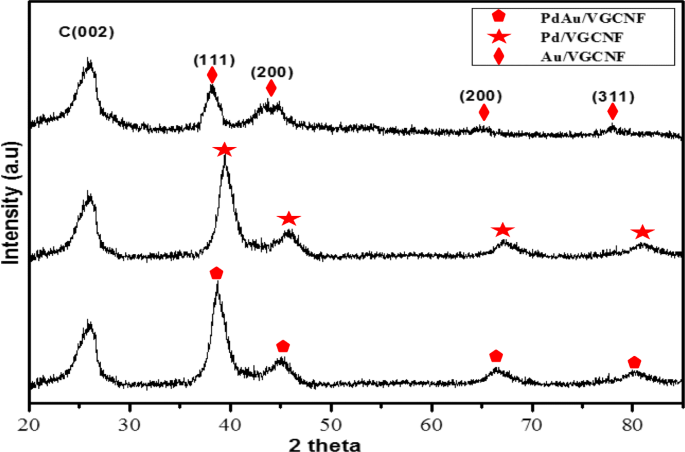
不同电催化剂Pd1Au1/VGCNF、Pd/VGCNF和Au/VGCNF的衍射图
图 1 显示了 Au/VGCNF 电催化剂样品在 38.3 °C、44.5 °C、64.7 °C 和 77.7 °C 附近的衍射峰,并且可以索引到晶面 (1 1 1)、(2 0 0)、( 2 2 0) 和 (3 1 1) 分别为 Fm-3m(JCPDS No. 65-8601,a =b =c =0.4072 nm)。图 1 显示了 Pd/VGCNF 电催化剂样品在 40.12 °C、46.66 °C、68.12 °C 和 82.10 °C 的 2θ 值附近的衍射图,对应于以下平面 (1 1 1), (2 0 0) 、(2 2 0)和(3 1 1)(JCPDS No.05-0681,a =b =c =0.3889 nm)。在图 1 中,对于 PdAu 双金属样品,Pd 和 Au 似乎共享一个衍射峰,表明已经发生了均匀的合金形成。
典型的 VGCNF 负载的 PdAu 纳米粒子基本上是由金属前驱体(即 \( {\mathrm{AuCl}}_4^{-} \) 和 \( {\mathrm{PdCl}}_4^{ 2-} \)) 在硼氢化钠作为还原剂的存在下。图 2a-c 显示了 Au/VGCNF、Pd/VGCNF 和 PdAu/VGCNF 电催化剂的典型 TEM 图像。可以看出,Au、Pd 和 PdAu 纳米颗粒形态表现出中等程度的团聚行为,在 VGCNF 上分布均匀。通过选区电子衍射 (SAED) 分析(插入图 2a-c)分析晶体结构图案,表明 Au/VGCNF、Pd/VGCNF 和 PdAu/VGCNF 是典型的 fcc 多晶结构。在图 2d 中观察到的高分辨率 TEM(HRTEM)图像,e 表示 0.24 nm 和 0.22 nm 的间距,这分别对应于 Au 和 Pd 的(111)面的面间距。图 2f 揭示了 d 由标记区域确定的晶格条纹间距值为 0.230 nm,对应于面心立方 (fcc) PdAu 合金的 (111) 平面。
<图片>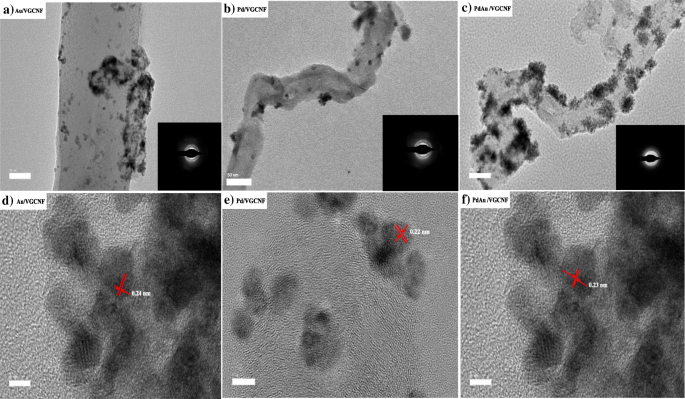
一 –c Au/VGCNF、Pd/VGCNF 和 Pd1Au1/VGCNF 的 TEM 和 SAED 图案的典型图像。 d –f Au/VGCNF、Pd/VGCNF和Pd1Au1/VGCNF电催化剂的HRTEM图像
BET 表面积和孔隙率分析是评估 Au/VGCNF、Pd/VGCNF 和 Pd1Au1/VCGNF 作为吸附剂的能力的有效工具。 BET 揭示了吸附材料(被吸附物)的数量及其在固体(吸附剂)上吸附剂表面的吸附程度[31]。使用氮吸附/解吸等温线分析 Au/VGCNF、Pd/VGCNF 和 Pd1Au1/VGCNF 样品的 BET 表面积,如图 3a 所示。等温线曲线反映了等温线的形状,并将提供材料孔隙率的定性评估。在这项研究中,观察到的等温线形状表明 Au/VGCNF、Pd/VGCNF 和 Pd1Au1/VCGNF 被发现是 IV 型(基于 IUPAC 分类),并且在 0.83–0.99 P/P0 的相对压力范围内显示出陡峭的斜率,这是存在介孔材料的特征 [32]。具有介孔结构的材料由于吸附量的增加而表现出良好的形态稳定性和活性催化剂,从而提高了催化活性。
<图片>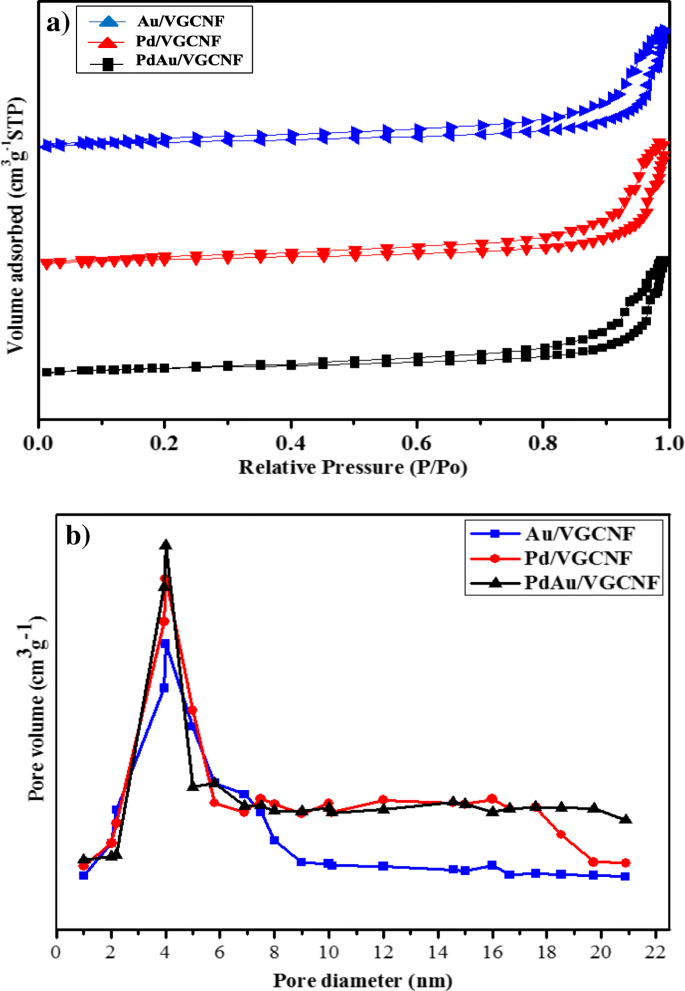
一 Au/VGCNF、Pd/VGCNF 和 Pd1Au1/VGCNF 的 N2 吸附/解吸等温线。 b Au/VGCNF、Pd/VGCNF和Pd1Au1/VGCNF的孔径分布曲线
电催化剂的表面积、孔体积和孔径值如表1所示。从表中可以看出,VGCNF的表面积为30.56 m 2 /g,孔体积为0.415 cm 3 /g,孔径为 7.0 nm。发现催化剂载体上方存在金属催化剂(Au、Pd 和 PdAu)会降低表面积、孔体积和孔径。这是由于催化剂金属已经分散并接触到催化剂载体的表面。即使催化剂金属分散在 VGCNF 上,H1 型磁滞回线(P/Po 0.83-0.99)表明材料的中孔结构不受影响。可以得出结论,催化剂金属已经很好地分散在VGCNF的表面上,并且与TEM图像一致,表明催化剂金属均匀地分散在催化剂载体的表面上。
从图 3a 所示的 Au/VGCNF、Pd/VGCNF 和 Pd1Au1/VCGNF 的 BJH 孔径分布可以看出,在 4 nm(孔径)附近显示出狭窄的孔径或孔径,而孔径范围在所有催化剂中观察到的 2 和 5 nm 之间,这使得该材料成为一种独特的吸附介质 [31]。与 VGCNF 相比,Au/VGCNF、Pd/VGCNF 和 Pd1Au1/VGCNF 电催化剂的孔体积较小,这是由于在纳米颗粒修饰过程中载体介质内部的一些多孔空间被金属催化剂纳米颗粒或其他化学反应堵塞,从而导致在孔体积的下降。然而,报告的 BET 表面积并不是指整个电催化表面积。因此,需要进行详细的电化学分析以获得活性表面积。
进行XPS分析以研究C 1s , Pd 3d , 和 Au 4f 在 Au/VGCNF、Pd/VGCNF 和 PdAu/VGCNF 电催化剂样品中。 C 1s 的高分辨率峰谱 峰值如图 4a 所示;可以观察到四种组分,即 284.6 eV (C-C)、285.4 eV (C-O-C)、286.6 eV (C-OH) 和 287.8 eV (C =O),这决定了电催化剂 VGCNF 的化学结构。 XPS 用于表征 Au/VGCNF、Pd/VGCNF 和 PdAu/VGCNF 的化学、电子状态和表面组成。表 2 显示了 Pd/VGCNF、Au/VGCNF 和 Pd1Au1/VGCNF 的重量百分比和结合能。图 4b 描绘了区域 Au 4f Au/C 和 PdAu/C 的光谱。在 Au 4f Au/VGCNF 的光谱,双峰包含一个低能带 (Au 4f 7/2) 和高能带 (Au 4f 5/2) 在 84.1 和 87.7 eV,这证实了 \( {\mathrm{AuCl}}_4^{2-} \) 减少到 Au 0 .在 Pd/VGCNF 的图 4c 中,峰值位于 335.4(Pd 3d 5/2) 和 340.7 eV (Pd 3d 3/2) 归因于 Pd 3d 这证实了 \( {\mathrm{PdCl}}_4^{2-} \) 减少到 Pd 0 .同时,对于双金属 PdAu/VGCNF,可以观察到 Au 4f 和 Pd 3d 与 Au/VGCNF 和 Pd/VGCNF 相比,略微偏离较低的角度。结合能的变化为电子从 Pd 转移到 Au 提供了强有力的证明,这可能与 Pd 和 Au 原子轨道之间的电子相互作用受到扰动有关,并进一步验证了合金纳米结构的形成。 Pd和Au的量可以通过峰强度确定,显示Pd与Au的比例为79:21,远高于计算值(50:50)。这意味着 Pd 原子富集在催化剂表面的外部。这是由于 Au(III) 和 Pd(II) 的还原率不同而发生的。可以假设首先形成金核,然后将钯原子添加到核上,并导致形成具有富钯表面的合金纳米结构。这一观察结果证实了Pd1Au1/VCGNF纳米催化剂样品外表面存在金属Pd和Au。
<图片>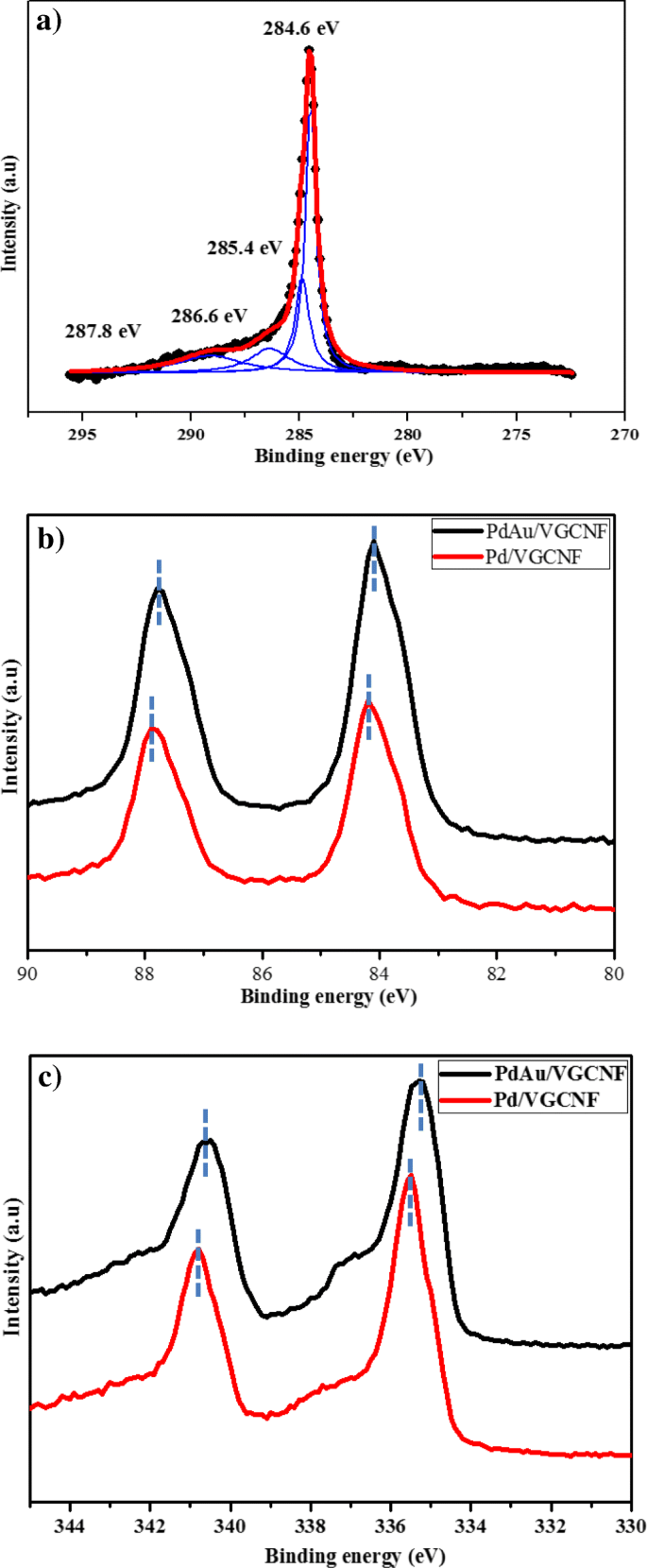
Pd/VGCNF、Au/VGCNF 和 Pd1Au1/VGCNF 的高分辨率 XPS 光谱。 一 Pd 4f 5/2 和 Pd 4f 7/2。 b Au 4f 5/2 和 Au 4f 7/2 和 c C 1s
基础溶液中甘油氧化的电化学分析
在将催化剂加载到玻碳电极上约 24 h 后进行催化剂的 CV 扫描。加载时间间接影响电流密度和峰值电位 (Ep)。随着加载时间的增加,从样品中析出的氢气总量需要更多的时间。从与氢解吸相关的起始电位开始,电流密度极大地增加。碱性溶液中典型的循环伏安曲线通常用于测定氢和氧在 0.5 M NaOH 溶液中对 Pd/VGCNF、Au/VGCNF 和 Pd1Au1/VGCNF 的吸附,如图 5 所示。电位范围内的区域 A从- 0.8 到- 0.5 V 可以单独指定为 H + 的吸附和解吸 电催化剂表面积上的离子。然而,吸附和解吸峰不能清楚地区分。 This is possibly caused by the blocking of certain electrocatalyst active sites upon the incorporation of the second metal [33]. In region B, in the intermediate potential between − 0.4 V and − 0.2 V, the catalyst behaves as an ideally polarizable catalyst (double layer region) where the surface has free-adsorbed H + 和 OH − . Meanwhile, the formation of oxides occurs in the forward scan at the higher potential more than − 0.2 V between 0.1 and 0.3 V. The oxide reduction peak at − 0.34 V is also observed during the reverse scan in region C [33]. Meanwhile, Au/VGCNF electrocatalyst shows a slightly different voltammetry standard curve, where region A is the large capacitive current associated with the double layer region and is a typical electrochemical behavior of the Au catalyst followed by area B where the absorption of hydroxyl OH − species and oxide formation is at higher potential above − 0.2 V vs Ag/AgCl, while area C is observed as a reduction region of Au oxides.
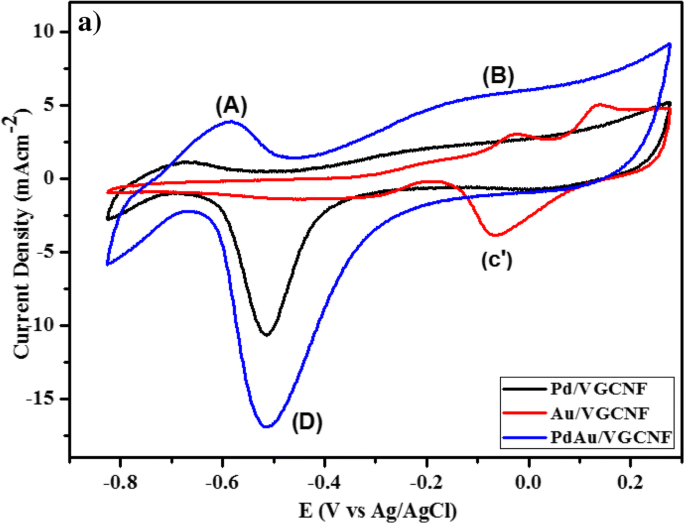
Cyclic voltammogram for Pd/VGCNF, Au/VGCNF, and Pd1Au1/VGCNF in 0.5 M glycerol
Figure 6 shows the anodic peak current density for Au/VGCNF, Pd/VGCNF, and Pd1Au1/VGCNF electrocatalysts for the oxidation of glycerol in alkaline medium. The performance in cyclic voltammetry curve of the prepared electrocatalysts towards the oxidation of the glycerol is seen in terms of four parameters:(1) onset oxidation potential, (2) forward anodic peak potential, (3) forward anodic peak current, and (4) CO tolerance as can be seen in Table 1 are investigated. The oxidation peak in forward scan can be attributed to the oxidation of freshly chemisorbed species from glycerol adsorption, and the oxidation peak in negative scan means the removal of carbonaceous species incompletely oxidized the forward scan. As a result, the ratio of the forward current density peak (I f) to the backward current density peak (I b) reflects the tolerance ability to carbonaceous species accumulation. A high ratio I f/I b indicates efficient oxidation of glycerol during the forward scan and little accumulation of carbonaceous residues. In terms of peak current density, Pd1Au1/VGCNF provided the best performance compared to Pd/VGCNF and Au/VGCNF. Besides that, Pd1Au1/VGCNF also shows the lowest onset potential (− 0.75 V vs.> − 0.60 for glycerol). The worst results were obtained with methanol, especially in terms of current density and oxidation overpotential. After a detailed perusal of the literature and estimating that the metal catalyst loading is very low (0.1 mg cm −2 ), one may readily realize that Pd1Au1/VGCNF can be classified among the most active electrocatalysts ever reported for the oxidation of glycerol in half-cells. The current density for glycerol oxidation with electrocatalysts Pd/C, Pt/C, and Au/C is significantly higher compared to Zhang et al. [26] due to higher catalyst loading and temperature dependence.
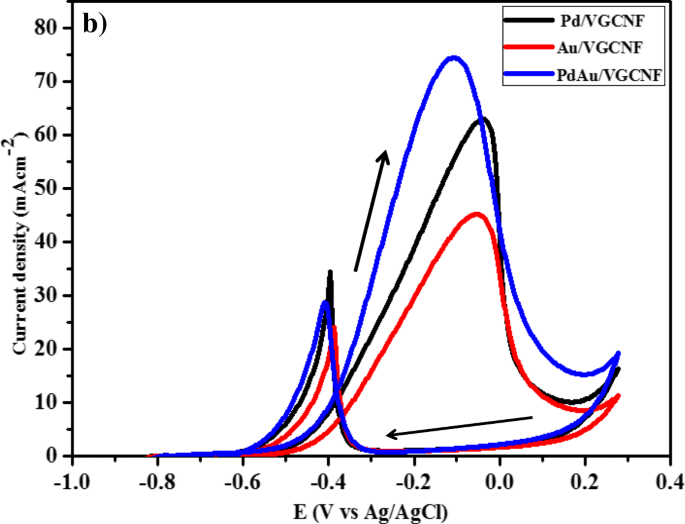
Cyclic voltammogram for Pd/VGCNF, Au/VGCNF, and PdAu/VGCNF in 0.5 M glycerol + 0.5 M NaOH
In Table 3, it exhibits that the bimetallic PdAu/VGCNF has high electrocatalytic activity towards the glycerol oxidation with respect to monometallic electrocatalyst. The presence of a second metal which is Au leads to a slight increase of the activity between 0.45 and 0.7 V versus Ag/AgCl, as higher current densities are achieved. Looking at CV curve (Fig. 6) recorded at Pd/VGCNF and Au/VGCNF electrocatalysts, both materials presented almost the same onset potential for the glycerol oxidation close to − 0.4 V vs Ag/AgCl. The onset potential for PdAu/VGCNF shifted towards a lower value due to the bifunctional mechanism which gives the catalytic improvement. In agreement with the bifunctional mechanism, Au is an oxyphilic material which has oxygen adsorbing character which promotes the chemisorbed species and assists the electrooxidation of glycerol leading to the decrease of the onset potential of glycerol electrooxidation and enhanced catalytic activity [34]. Besides that, bimetallic electrocatalysts PdAu/VGCNF also examined excellent CO tolerance, when the ratio I f/I b is superior than others, which reveals the higher catalytic efficiency for direct oxidation during the forward scan.
Tafel Analysis
Figure 7a–c shows a Tafel plot of all the electrocatalysts tested in the reaction of the glycerol oxidation. Each Tafel plot shows two linear areas with an increase in Tafel slope. The Tafel slope is one of the kinetic parameters associated with the determination of a reaction that occurs on the surface of the electrode. At low oxidation potential (Ev), the Tafel slope is low which indicates the kinetic transfer charge is fast during the reaction of the glycerol oxidation. At higher oxidation potential (Ev), the value of the second Tafel slope is greater which indicates that the electrocatalytic reaction mechanism changes. The change in Tafel slope can be attributed to the kinetic rate of the charge transfer in the reaction decrease due to the presence of intermediate species which can poison the surface of the electrocatalysts (Kang et al. [35]).
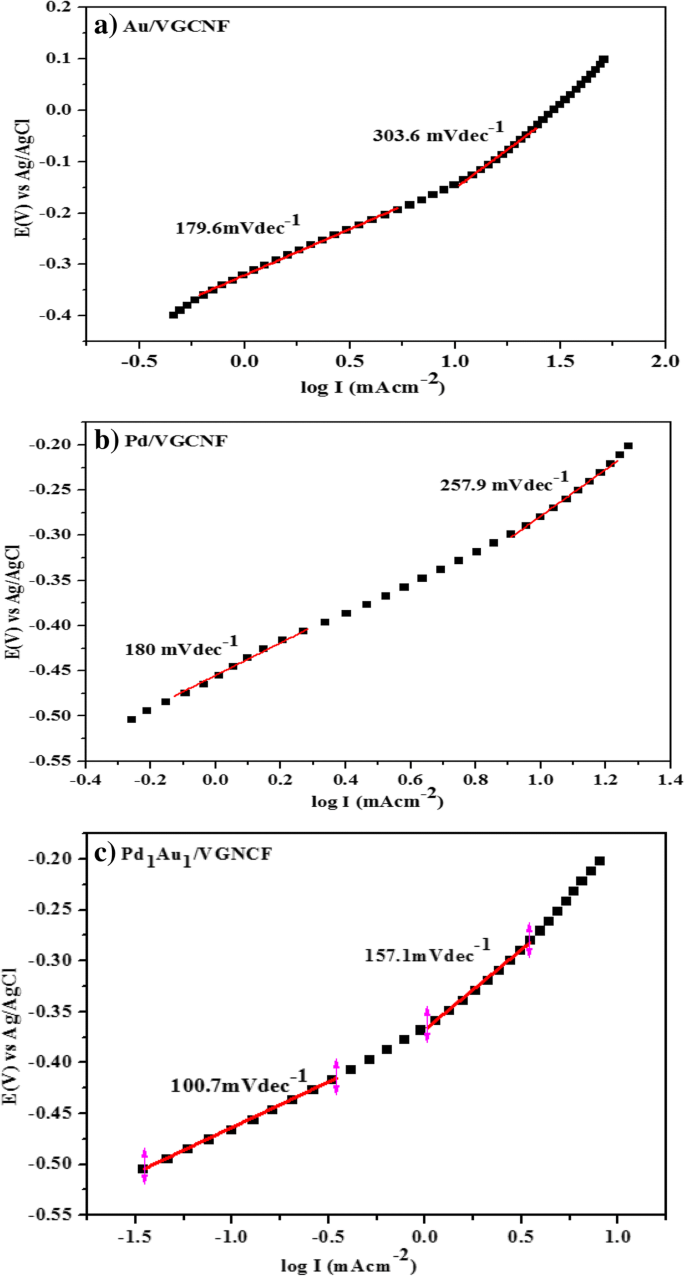
Tafel slope for Au/VGCNF, Pd/VGCNF, and Pd1Au1/VGCNF electrocatalysts in solution (0.5 M NaOH + 0.5 M Glycerol) at scanning rate 50 mVs − 1
Table 4 lists the values of Tafel slope obtained on low and high potential oxidation. The Tafel slope for Pd1Au1/VGCNF electrocatalyst is lower than Pd/VGCNF and Au/VGCNF indicating that the charge transfer kinetic on bimetallic electrocatalyst is faster than single metal electrocatalyst for the glycerol oxidation reaction. Once the potential oxidation (Ev) is increased, the Tafel slope also increased from low to high. This indicates that the reaction mechanism of the glycerol oxidation changes over the first one. Similar to the phenomenon occurring in other alcohol oxidation such as methanol [36] and ethanol [37], the maximum mass transfer of glycerol occurs in high potential oxidation (Ev) which makes the hydroxyl adsorption and formed the oxide layer at electrocatalysts surface.
Performance of Au/VGCNF, Pd/VGCNF, and PdAu/VGCNF in Direct Glycerol Fuel Cell
Electrochemical I-V Characterization
Reliability of any synthesized electrocatalyst can generally be defined as the probability of the electrocatalyst to carry out its desired activity, which in this study is the catalysis for direct glycerol fuel cell applications. Although the electrocatalyst was analyzed earlier using a half-cell and showed good performance, the application of the electrocatalyst in direct glycerol fuel cells does not show outstanding performance. Figure 8 illustrates the cell polarization and power density curves of DGFC with FAA-3 (FuMA-Tech) membrane which show the passive DGFC single cell test results for Au/VGCNF, Pd/VGCNF, and Pd1Au1/VGCNF. From the DGFC performance test, results clearly show that the OCV and power density of Pd1Au1/VGCNF are higher compared to Pd/VGCNF and Au/VGCNF electrocatalysts. Table 5 lists the performance of all electrocatalysts in DGFC application in this study. In terms of electrocatalysts prices, roughly the price for Pd1Au1/VGCNF is USD 0.26/mg cheaper than the price for black Pd commercial which is USD 0.41/mg.
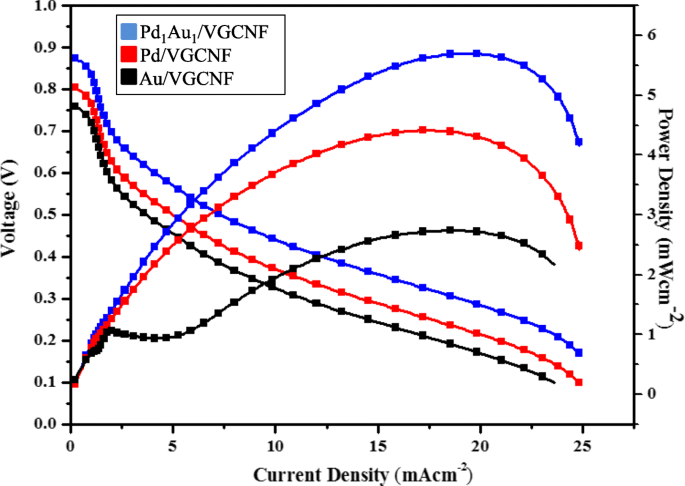
Polarization and power density curves for direct glycerol fuel cell (DGFCs) using PdAu/VGCNF at 25 ° C
Passive-performance alkaline fuel cell may not be able to challenge the performance of the active fuel cell. One of the main problems for the passive alkaline fuel cell is related to the liquid electrolyte such as NaOH or KOH. This is due to the very spontaneous reaction with the NaOH electrolyte solution which is very sensitive to the presence of CO2 from the air [38]. The use of air instead of oxygen will expose the hydroxyl ions to CO2 contained in the air and will lead to the formation of Na2CO3 or K2CO3. The presence of carbonates will indirectly reduce the amount of OH ions in the anode and thereby reduce the ionic conductivity [39]. Too much carbonate will block the pores of the gas diffusion layer and can severely degrade the performance of the single cell [31,32,33] .
Electrochemical Impedance Spectroscopy
The performance of the direct glycerol fuel cell assessed by polarization curves does not reflect and give enough information about the condition of the inner component. Thus, electrochemical impedance spectroscopy (EIS) has to be carried out together with polarization curve measurements to evaluate the overall kinetic performance such as distinguishing the influences (voltage drop caused by charger transfer, membrane or mass transfer resistance) of the different processes (kinetic, ohmic, or mass transport dominated) in the whole electronic system [40]. Figure 9a–c shows the Nyquist plots which are one typical curve of electrochemical impedance spectroscopy (EIS) for three different types of electrocatalysts. Generally, the diameter of the semicircle arc is to measure the charge–transfer resistance for glycerol oxidation reactions. Apparently, the DIA in Fig. 9 showed the order as follows:Au/VGCNF > Pd/VGCNF > PdAu/VGCNF. This suggests that PdAu/VGCNF has the greatest charge transport performance, which was consistent with the abovementioned outstandingly excellent electrochemical catalytic activity. Besides that the equivalent circuit which was fit to EIS spectra shown in Fig. 9d in which Rs represents the solution resistance and Rct represents the charge–transfer resistance for the process of glycerol electrocatalytic oxidation. Overall, the Rct value for PdAu/VGCNF is much smaller compared to other electrocatalyst which reveals that the electron transfer for glycerol oxidation on PdAu/VGCNF is much easier, which could enhance the electrocatalytic activity of the electrocatalyst for glycerol oxidation.
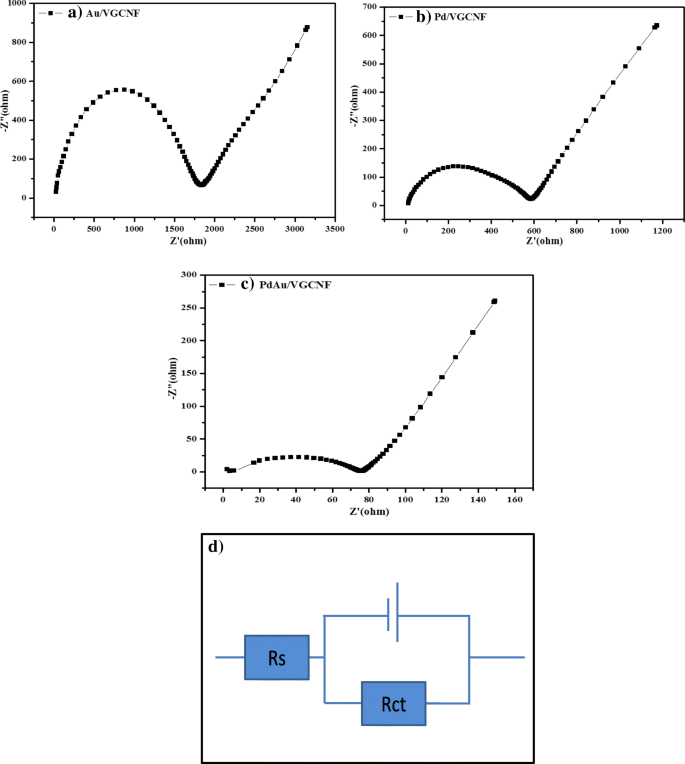
Nyquist plots of electrochemistry impedance spectra for glycerol oxidation reaction of a Au/VGCNF, b Pd/VGCNF, c PdAu/VGCNF, and d circuit.
Since there is no difference in the MEA and cell assembly between the two cells, the lower resistance of PdAu/VGCNF cell can be attributed to the catalyst layer. In the PdAu/VGCNF-coated layer, small catalyst particle size can allow sufficient humidifying water to be held in the electrode and the uniform particle distribution can prevent the agglomeration effect, which may lead to the increasing boundary resistance. Furthermore, the small particle and uniform distribution can decrease the migration path of ions, which can further reduce the distributed resistance. The high-frequency EIS results provide the information that in the real fuel cell operation, the smaller cathode catalyst particle size will not only facilitate the ORR kinetics, but also reduce the performance loss that is due to the ohmic and contact resistances.
MEA Morphology Analysis
Basically, the low performance of the fuel cell may be due to the inherent properties of the materials used in fuel cell construction, defects in the materials, and the assembly process of the fuel cell. Below, we further discuss the potential effects that give rise to the lower performance of direct glycerol fuel cell.
Microporous Layer (MPL) Cracking
To justify the low performance of direct glycerol fuel cell, the morphology of some MEA were evaluated by SEM after the performance evaluation in the fuel cell. Figure 10a shows the typical SEM surface image for the microporous layer (MPL) consisting of the carbon black layer and the catalyst layer. Cracks were observed on the catalyst surface. The formation of wrinkles and cracks that occur in the MPL is likely due to a chemical reaction that cannot be controlled during the operation of single cell. This reaction probably causes dimensional changes in the polymer electrolyte membrane such as volume expansion and contraction that occur due to the hydrothermal stresses during the fuel cell operation [41]. Catalyst drying process occurs irregularly, causing cracks in the catalyst layer [42]. The fuel cell still can be operated in the presence of catalyst cracking. However, this indirectly degrades the fuel cell performance.
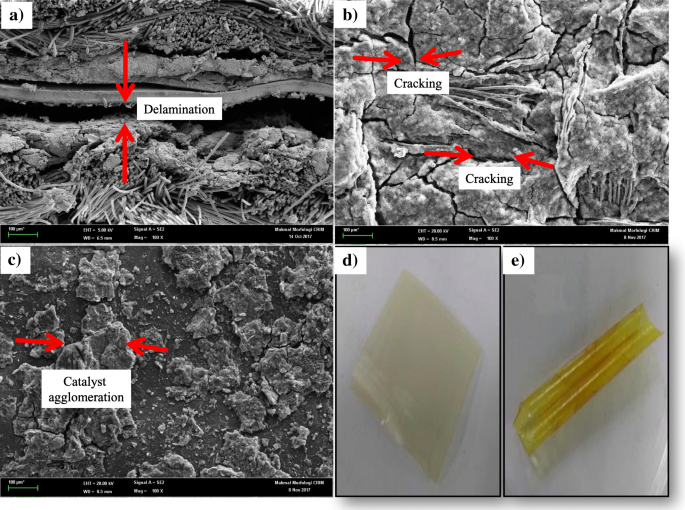
一 Delamination. b MPL cracking. c Catalyst agglomeration
Delamination
The SEM image presented in Fig. 10b clearly shows an obvious gap between the membrane and the electrodes after the operation of the direct glycerol fuel cell. This could be caused by the thermal expansion mismatch between the membrane and electrodes occurring during the operation of the fuel cell. In addition, this may also occur during the manufacturing process of the MEA such as owing to a too high temperature used during the catalyst layer drying process, which may form a vapor which will be trapped and thereby create an area where the adhesion between the two layers is poor [43]. Nevertheless, the electrolyte in the catalyst ink is expected to act as a binder during the lamination process. However, this may not occur in practice because the manual catalyst casting will lead to wrinkles on the electrode resulting in the existence of voids between the layers and subsequent degradation in the performance. Another reason for the gap in the interface may be the fact that mechanical hot pressing is difficult to ensure a fully intimate membrane–electrode interface. This is another factor which affects the fuel cell performance. This condition will increase the contact resistance and will require a longer time for the proton to travel to the catalyst sites and the existence of dead zone can occur which indirectly led to the loss of catalyst activity.
Orientation of Catalyst Layer
The catalyst layer was cast by manual casting. This method is difficult to control, and it has the potential to cause the agglomeration of undispersed catalyst powder [44, 45]. Figure 10c shows the areas corresponding to the agglomeration of nanoparticles on the MPL layer. This can create contact resistance over the entire MEA and therefore adversely impact the porosity or proton conductivity.
AEM Stability
The anion exchange membrane (AEM) shows some technological and scientific limitation. AEM suffers from a poor chemical stability in alkaline media arising from the hydroxide attack on the cationic group and resulting in the decreased anionic conductivity [46]. The AEM with OH − ion is less stable because AEM is easily converted to the less conductive \( {\mathrm{CO}}_3^{2-} \) and even less conductive \( {\mathrm{HCO}}_3^{-} \) forms when exposed to air even for short time. Figure 10d, e shows the comparison between before and after the treatment with alkali, indicating that AEM faced the problem of high swelling with the increased hydration [47]. This is a challenge in the handling of AEM. AEM is used to overcome the Nafion membrane degradation problem. However, AEM has a tendency to be hydrocarbon or aromatic based which gives rise to poor oxidation stabilities [41].
Conclusion
The palladium-based electrocatalysts supported with VGCNF was synthesized and characterized in this work as effective electrocatalysts for the electrooxidation in the alkaline environment of glycerol as renewable resources. The well-dispersed Au, Pd, and Pd1Au1 verified by XRD, TEM, and HTREM on VGCNF help to reduce the precious metal loading and served as a high reaction zone. The oxidation of glycerol has been primarily investigated by a variety of electrochemical techniques. The results obtained have highlighted the excellent electrocatalytic activity of bimetallic electrocatalyst which is PdAu/VGCNF as high as 74.45 mA cm −2 followed by Au/VGCNF and Pd/VGCNF. The high electrocatalytic activity of Pd1Au1/VGCNF could be related to the high dispersion of the metal particles and to the intrinsic properties of the VGCNF. In addition, the performance of passive DGFC applying MEA with the synthesized Pd1Au1/VGCNF was evaluated. The peak power density of the passive DMAFC was 3.9 mW cm −2 , for glycerol concentration of 2.0 M and NaOH concentration of 5.0 M. The EIS showed that PdAu/VGCNF shows smaller arc which indicates a smaller kinetic resistance in comparison with two other electrocatalysts. The extensive evaluation of single cell manufacturing indicates that power output performance is also affected by GDL morphological defects, MEA manufacturing, and AEM stabilities. Therefore, it is apparent that more research on alkaline fuel cell is needed to address the problem relevant for improving the reliability during the long-term operation of DMFCs.
缩写
- AEM:
-
Anion exchange membrane
- Au:
-
Aurum
- 赌注:
-
Brunauer, Emmett, and Teller
- 简历:
-
循环伏安法
- EDX:
-
Energy-dispersive X-ray
- FESEM:
-
场发射扫描电镜
- HAuCl4·3H2O:
-
Gold(III) chloride trihydrate
- MPL:
-
Microporous layer
- N2 :
-
氮气
- Pd:
-
Palladium
- PdCl2 :
-
Palladium chloride
- 聚四氟乙烯:
-
聚四氟乙烯
- VGCNF:
-
Vapor-grown carbon nanofiber
- XPS:
-
X射线光电子能谱
- XRD:
-
X射线衍射
纳米材料
- 什么是直喷引擎?
- 聚合物纳米结构上 U2OS 细胞中肌动蛋白和焦点粘附组织的分析
- Au 纳米颗粒对 HT29 和 SPEV 细胞系影响的体外研究
- 斜角溅射 ITO 电极在 MAPbI3 钙钛矿太阳能电池结构中的影响
- 通过静电纺丝法制备用于直接甲醇燃料电池的新型复合二氧化钛碳纳米纤维阳极催化剂的制备和表征
- 增强新型阳极 PdAu/VGCNF 催化剂在甘油燃料电池中的电氧化性能
- 具有超弹性和高电容的石墨烯/聚苯胺气凝胶作为高抗压超级电容器电极
- 支持直接甲醇燃料电池的新型阳极催化剂:表征和单电池性能
- 荧光新糖蛋白金纳米团簇:合成及在植物凝集素传感和细胞成像中的应用
- 用于直接甲醇燃料电池应用的各种碳载体和导电聚合物上的铂基催化剂:综述
- 氧化石墨烯对无源碱性直接乙醇燃料电池中 QPVA 基膜的乙醇渗透性和离子电导率的影响
- 燃油喷射和化油器的区别


